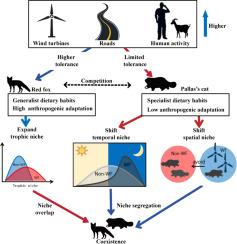Contrasting effects of wind farm disturbances on multi-dimensional competition and coexistence of sympatric mesocarnivores
IF 4.4
1区 环境科学与生态学
Q1 BIODIVERSITY CONSERVATION
引用次数: 0
Abstract
Wind power generation is expanding rapidly as a sustainable energy development solution to mitigate climate change. However, a significant knowledge gap remains regarding the impacts of wind farm (WF) development on wildlife, particularly how different species respond to the disturbance from WFs. To address this, we used camera-trapping surveys and fecal-DNA metabarcoding data collected from both WF and non-WF areas. We aimed to investigate the multi-dimensional effects of WF disturbances on the competition and coexistence between two key mesocarnivores, red foxes (Vulpes vulpes) and Pallas's cats (Otocolobus manul) in the Hexi Corridor, Northwest China. Given their distinct ecological characteristics and responses to human disturbances, we hypothesized that WF disturbances would differentially affect both species across spatial, temporal and diet niche dimensions. As expected, WF disturbances diminished prey availability and increased trophic niche overlap. Temporal niches playing a crucial role in facilitating coexistence through Pallas's cats shifting their daily activity patterns to reduce overlap with human activity. Despite significant differences in habitat preferences, spatial niche overlap between the two species remained similar across WF and non-WF areas, likely due to prey availability and livestock distribution. Our results highlight the complex interplay of spatial, temporal, and trophic niche dimensions in mitigating competition and promoting coexistence among sympatric carnivore species. Our findings provide guidance for balancing renewable energy goals with biodiversity conservation, emphasizing the importance of habitat preservation, prey management, and WF placement strategies during WF development.

风电场干扰对同域中食性动物多维竞争与共存的对比影响
风力发电作为减缓气候变化的可持续能源发展解决方案正在迅速发展。然而,关于风力发电场发展对野生动物的影响,特别是不同物种如何应对来自风力发电场的干扰,仍然存在重大的知识缺口。为了解决这个问题,我们使用了摄像机捕获调查和从野生动物保护区和非野生动物保护区收集的粪便dna元条形码数据。本研究旨在探讨WF干扰对河西走廊两种主要中食性动物——红狐(Vulpes Vulpes)和黄猫(Otocolobus manul)竞争与共存的多维影响。考虑到它们不同的生态特征和对人类干扰的响应,我们假设WF干扰会在空间、时间和饮食生态位维度上对两个物种产生不同的影响。正如预期的那样,WF干扰减少了猎物的可得性,增加了营养生态位重叠。通过改变帕拉斯猫的日常活动模式,减少与人类活动的重叠,时间壁龛在促进共存方面发挥着至关重要的作用。尽管栖息地偏好存在显著差异,但两种物种之间的空间生态位重叠在WF和非WF区域保持相似,这可能是由于猎物可得性和牲畜分布所致。我们的研究结果强调了空间、时间和营养生态位维度在减轻同域食肉动物物种之间的竞争和促进共存方面的复杂相互作用。我们的研究结果为平衡可再生能源目标与生物多样性保护提供了指导,强调了栖息地保护、猎物管理和野生动物在野生动物发展过程中的放置策略的重要性。
本文章由计算机程序翻译,如有差异,请以英文原文为准。
求助全文
约1分钟内获得全文
求助全文
来源期刊

Biological Conservation
环境科学-环境科学
CiteScore
10.20
自引率
3.40%
发文量
295
审稿时长
61 days
期刊介绍:
Biological Conservation is an international leading journal in the discipline of conservation biology. The journal publishes articles spanning a diverse range of fields that contribute to the biological, sociological, and economic dimensions of conservation and natural resource management. The primary aim of Biological Conservation is the publication of high-quality papers that advance the science and practice of conservation, or which demonstrate the application of conservation principles for natural resource management and policy. Therefore it will be of interest to a broad international readership.
 求助内容:
求助内容: 应助结果提醒方式:
应助结果提醒方式:


